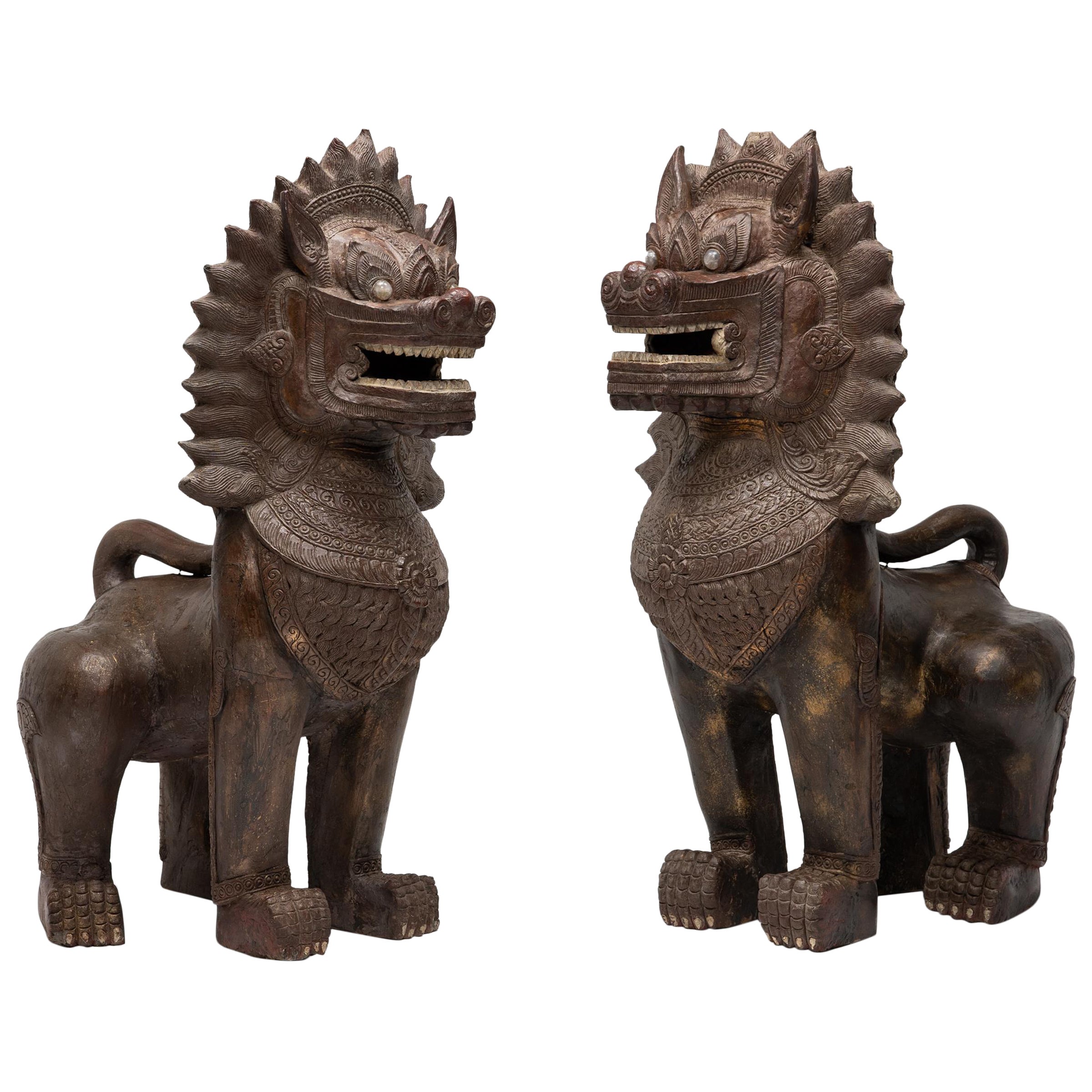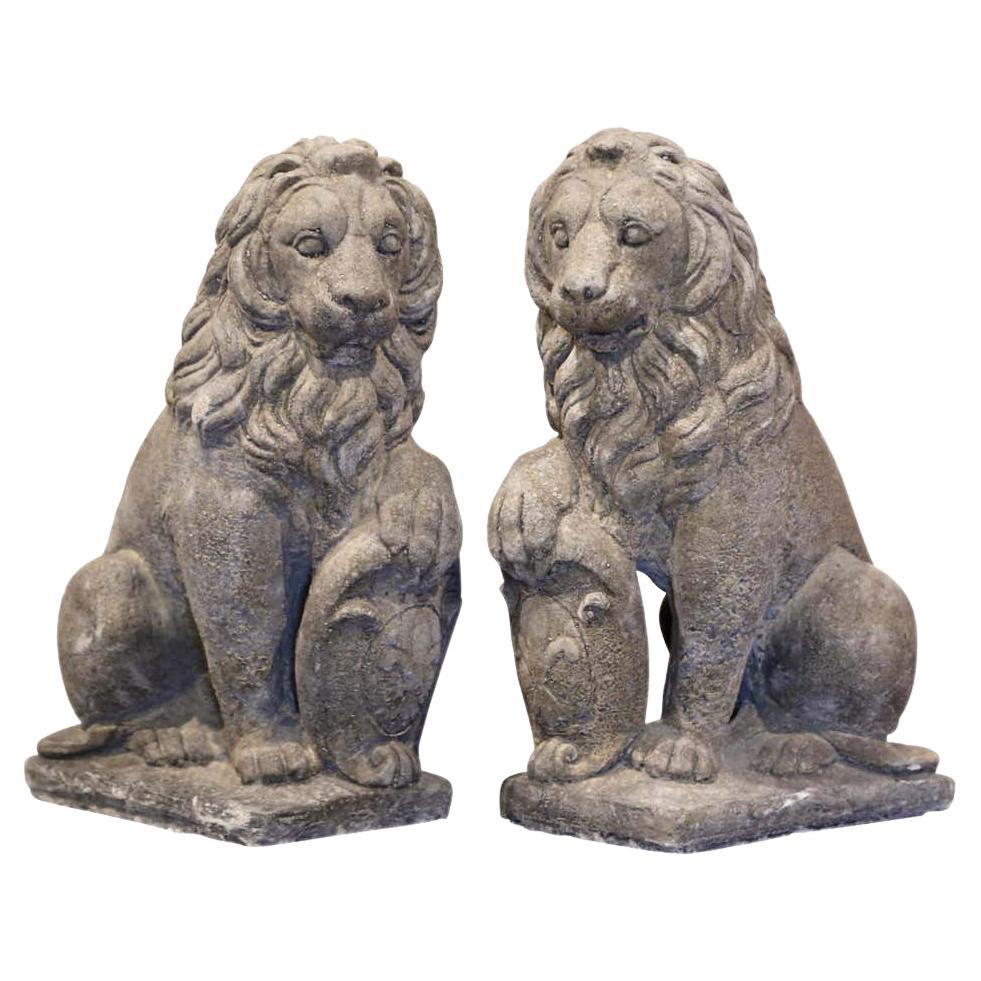Items Similar to Pair of 1615 English Polychrome Painted Heraldic Lion Newel Banisters Finials
Want more images or videos?
Request additional images or videos from the seller
1 of 21
Pair of 1615 English Polychrome Painted Heraldic Lion Newel Banisters Finials
About the Item
Wer are delighted to offer this exceptionally rare pair of King James 1st 1615 English Heraldic Lion Newel Finials with period Polychrome paint
Where to begin! What a find, these are original English Newel Finials which would have been used at either end of a bannister, they are totally and utterly unrestored and haven’t changed one bit in the last 405 years of their existence
They can be used as pure decoration, they are freestanding and really define a space, alternatively they still have the original mounting holes to the base, they could be used as reclaimed bannister terminals once again
Dimensions
Height 37cm & 36cm
Width 16cm & 13cm
Depth 12cm & 17cm
Please note all measurements are taken at the widest point
Heraldic beasts were used in many different interiors: country houses; townhouses; livery halls; boardrooms of various institutions; churches and places of worship; and warships. As a result, the purpose for which these pieces may have been carved remains unclear. This pair of heraldic beasts may have been carved as newel post finials of a grand staircase; or as finials for a church or a livery hall.
John Crowther (1837-1902)’s ‘Interior View of the Church of St Matthew, Friday Street’, a watercolor painted in 1881, demonstrates the use of such carvings within the interior of a church. In 20th century Britain, over 1,000 country houses were demolished. This phenomenon was brought about by a change in social, political and financial conditions – high taxation, death duties, and the loss of aristocratic heirs as well as workers to manage the estates following the two World Wars – which led to landed families selling estates and a large number of country houses being demolished.
On 4 May 1912 ‘Country Life’ carried an advertisement for the ‘Stone Balustrade containing 140 turned balusters; 80 half-balusters; 13 massive pillars’ and ‘13 urns’ from Trentham Hall, Staffordshire, which were being sold for £200. This was a hint of things to come.
In 1944 the trustees of Castle Howard began selling the contents of the house; the Duke of Bedford reduced Woburn Abbey to half its original size in 1947; and Alfred Waterhouse’s Eaton Hall was razed to the ground in 1963. From the turn of the 20th century, interior woodwork, including complete panelled rooms, staircases and fittings such as these heraldic beasts secured an active market amongst rich Americans.
Bibliography: Anthony Wells-Cole, ‘Art and Decoration in Elizabethan and Jacobean England: The Influence of Continental Prints, 1558-1625’ (Paul Mellon Centre for Studies in British Art, Yale University Press New Haven & London, 1997).
This item is available for collection from our Wimbledon warehouses
Condition
Please view the very detailed pictures as they form part of the description around condition
Please note vintage period and original items such as leather seating will always have natural patina in the form of cracking creasing and wear, we recommend regular waxing to ensure no moisture is lost, also hand dyed leather is not recommended to sit in direct sunlight for prolonged periods of time as it will dry out and fade.
- Dimensions:Height: 14.57 in (37 cm)Width: 6.3 in (16 cm)Depth: 4.73 in (12 cm)
- Sold As:Set of 2
- Style:Jacobean (Of the Period)
- Materials and Techniques:
- Place of Origin:
- Period:1610-1619
- Date of Manufacture:1615
- Condition:Wear consistent with age and use. Minor fading.
- Seller Location:GB
- Reference Number:1stDibs: LU2823320308342
About the Seller
4.6
Platinum Seller
These expertly vetted sellers are 1stDibs' most experienced sellers and are rated highest by our customers.
Established in 2012
1stDibs seller since 2017
1,711 sales on 1stDibs
Typical response time: <1 hour
- ShippingRetrieving quote...Ships From: United Kingdom
- Return PolicyA return for this item may be initiated within 14 days of delivery.
More From This SellerView All
- Stunning Antique circa 1860 Hand Carved English Oak Recumbent Lion StatueLocated in GBWe are delighted to offer for sale this stunning recumbent Lion carved statue on plinth base A very good looking well made and decorative piece, its hand carved from one piece on ...Category
Antique 1860s English High Victorian Animal Sculptures
MaterialsOak
- Pair of Vintage Hand Carved Male Lion Stools with Ornate Decoration All overLocated in GBWe are delighted to offer for sale this stunning pair of hand carved African Lion stools with ornate detailing all over. A very good-looking pair of decorative stools...Category
20th Century European Mid-Century Modern Stools
MaterialsWood
- 1840 Italain Venetian Cabinet on Stand Polychrome Painted & Lion Heads CarvingsLocated in GBWe are delighted to offer for sale this sublime circa 1840 Italian Venetian Polychrome painted cabinet on stand with Lion head carved silver l...Category
Antique 1840s Italian Early Victorian Cabinets
MaterialsOak
- PAIR OF ANTIQUE 1640 CAQUETOIRE CARVED WALNUT POLYCHROME PAINTED ARMCHAIRsLocated in GBRoyal House Antiques Royal House Antiques is delighted to offer for sale this super rare pair of totally original 17th century circa 1640-1680 French Caquetoire armchairs with ornat...Category
Antique 1640s French Charles II Armchairs
MaterialsWalnut
- Fine Antique circa 1800 Hand Carved Royal Armorial Lion from Coat of Arms CrestLocated in GBWe are delighted to offer for sale this stunning circa 1800 hand carved Royal English Armorial Crest / Coat of Arms Lion. A truly stunning piece,...Category
Antique Early 1800s English George III Animal Sculptures
MaterialsWood
- Pair of George III 1780 Satinwood & Tulip Wood Polychrome Painted Console TablesLocated in GBWe care delighted to offer for sale this very fine pair of satinwood and tulipwood polychrome painted George III serpentine console tables An exquisite pair of fine English circa ...Category
Antique 1780s English George III Console Tables
MaterialsSatinwood, Tulipwood
You May Also Like
- American Turned Newel Finial PostLocated in Chicago, ILDated to the early 20th century, this antique turned newel post was crafted from American oak with a simple ball finial top. The original dark finish...Category
Early 20th Century American Folk Art Mounted Objects
MaterialsOak
- Pair Of Heraldic Lions, Oak Sculptures, 19th CenturyLocated in Honnelles, WHTPair of heraldic lions, oak sculptures, 19th centuryCategory
Antique 19th Century European Louis XIII Animal Sculptures
MaterialsOak
- Pair of Polychrome Khmer Guardian Lions, c. 1850Located in Chicago, ILGrand and imposing, these monumental lion sculptures offer protection to all those who stand before them. Dated to the mid-19th century, the ...Category
Antique Mid-19th Century Southeast Asian Chinese Export Animal Sculptures
MaterialsCrystal
- Pair of French Carved Stone Heraldic Lions Sculptures Garden StatuaryLocated in Dallas, TXCarved of stone in France circa 2000 and set on a rectangular integral base, the vintage feline statues are seated on their back legs while holding a Fle...Category
Early 2000s French Animal Sculptures
MaterialsStone
- Pair of Antique English Brass Ball FinialsLocated in Wormelow, HerefordshireA pair of large antique English cast brass ball finials, salvaged from a stables in Newmarket, England. With their bold brass colour and highly polished finish, this impressive pair...Category
Antique Mid-19th Century English Regency Mounted Objects
MaterialsMetal, Brass
- Antique English Heraldic Tile Earl of DerbyLocated in Wormelow, HerefordshireA hand decorated antique English heraldic tile by J. D. Rochfort dating from 1881. This porcelain tile is one of 14 similar we are selling, removed from the now demolished library of...Category
Antique Late 19th Century English Victorian Mounted Objects
MaterialsPorcelain





